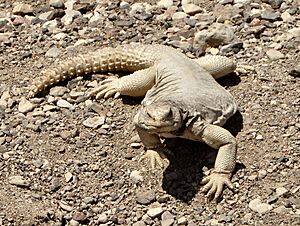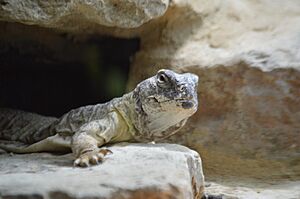Uromastyx aegyptia facts for kids
Quick facts for kids Uromastyx aegyptia |
|
|---|---|
 |
|
| Conservation status | |
| Scientific classification | |
| Genus: |
Uromastyx
|
| Species: |
aegyptia
|
| Synonyms | |
|
|
The Egyptian Spiny-Tailed Lizard (scientific name: Uromastyx aegyptia) is a cool type of lizard. It belongs to a family of lizards called Agamidae. You can only find this lizard in certain parts of North Africa and the Middle East.
Contents
What's in a Name?
- This lizard has a few different common names. People often call it the Egyptian Spiny-Tailed Lizard or the Egyptian Mastigure.
- One special type of this lizard is called Leptien's Mastigure.
How Big Are They?
- The Egyptian Spiny-Tailed Lizard is one of the biggest lizards in its group!
- Male lizards can grow to be about 76 centimeters (30 inches) long. That's almost as long as a baseball bat!
Where Do They Live?
- These lizards live in dry, rocky areas. You can find them in countries like Egypt (east of the Nile River), Israel, Syria, Jordan, the Arabian Peninsula, Iraq, and Iran.
- They like open, flat places with lots of gravel, stones, and rocks. They can live high up, even at 1,500 meters (about 4,900 feet) above sea level.
Are They in Danger?
- Sadly, the Egyptian Spiny-Tailed Lizard is becoming rare in many places.
- Their homes are disappearing because of things like building and farming.
- Also, too many of them are being caught, which makes their numbers go down.
Different Kinds of Egyptian Spiny-Tailed Lizards
- Scientists have found three different types, or subspecies, of the Egyptian Spiny-Tailed Lizard.
- These are like different versions of the same animal.
- Here are the three recognized types:
- Uromastyx aegyptia aegyptia (named by Forskål in 1775)
- Uromastyx aegyptia leptieni (named by Wilms & Böhme in 2000)
- Uromastyx aegyptia microlepis (named by Blanford in 1874)
How Did They Get Their Name?
- The name leptieni for one of the subspecies honors a German scientist.
- His name was Rolf Leptien, and he studied reptiles and amphibians.
How People Used Them
- In some places, people call this lizard dhab or ḍabb.
- Long ago, the strong skin of these lizards was used to make leather by the bedouin people.
- Sometimes, their meat was also eaten as a source of food.

All content from Kiddle encyclopedia articles (including the article images and facts) can be freely used under Attribution-ShareAlike license, unless stated otherwise. Cite this article:
Uromastyx aegyptia Facts for Kids. Kiddle Encyclopedia.


